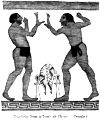Pugilātus
(
πύξ, πυγμή, πυγμαχία, πυγμοσύνη). Boxing. The fist
being the simplest and most natural weapon, it may be taken for granted that boxing was one of
the earliest athletic games among the Greeks. Hence even gods and several of the earlier
heroes are described either as victors in the
πυγμή or as
distinguished boxers, such as Apollo, Heracles, Tydeus, Polydeuces, and others (Theocrit.
xxiv. 113;
Apollod. iii. 6.4; Pausan. v. 8, 2). The Scholiast
on Pindar (
Nem. v. 89) says that Theseus was believed to have invented the art of
boxing. The Homeric heroes are well acquainted with it (
Hom.
Il. xxiii. 691; cf.
Homer Od.
viii. 103 foll.). Boxing for men was introduced at the Olympic Games in Ol. 23, and
for boys in Ol. 37 (Pausan. v. 8.3). Contests in boxing for boys are also mentioned in the
Nemea and Isthmia (Pausan. vi. 4.6).
In the earliest times boxers (
pugiles,
πύκται) fought naked, with the exception of a
ζῶμα round their loins (
Hom. Il. xxiii.
683;
Verg. Aen. v. 421); but this was
not used when boxing was introduced at Olympia, as the contests in wrestling and racing had
been carried on here by persons entirely naked ever since Ol. 15. Respecting the leathern
thongs with which pugilists surrounded their fists, see
Caestus, where its various forms are illustrated by woodcuts.
The boxing of the ancients appears to have resembled the practice of modern times. It was a
point of skill, we are told, not to attack the antagonist, but to remain on the defensive, and
thus to wear out the opponent, until he was obliged to acknowledge himself to be conquered
(
Eustath. ad Il. p. 1322, 29). It was considered a
merit in a boxer to conquer without receiving any wounds, so that the two great points in this
game were to inflict blows, and at the same time not to expose one's self to any danger. As
regards the position of the hands, no doubt it varied according to circumstances, then as now.
In art-representations we see sometimes the right arm guarding and the left striking,
sometimes the contrary: the blows were directed against the upper parts of the body, and
 |
|
Pugilists, from a Tomb at Chiusi. (Dennis.)
|
the wounds inflicted on the head were often severe (
Homer
Od. xviii. 96;
Apollon. Rhod. ii. 785;
Theocrit. ii. 126;
Verg. Aen. v. 469; Aelian,
V. H. x. 19). The ears especially were exposed to great danger, and with
regular pugilists they were generally much mutilated and broken (Plato,
Gorg.
p. 516;
Protag. p. 342; Martial, vii. 33, 5). Hence in works of art the ears of
the pancratiasts always appear beaten flat, and, although swollen in some parts, are yet
smaller than ears usually are. In order to protect the ears from severe blows, little covers,
called
ἀμφωτίδες, were invented (
Poll.ii. 82). But these ear-covers were undoubtedly never used in the great public
games, but only in the gymnasia and palaestrae, or at most in the public contests of boxing
for boys; for they are never seen in any ancient work of art.
Two points of distinction between ancient and modern pugilists may be noticed:
1.
that, as we gather from vase-pictures, the fist was not constantly doubled, as with us, but
the fingers were often merely curved over, sometimes almost extended; in some
representations, however, the fists are fairly clenched: probably the differences are due to
the caestus;
2.
the inarticulate sounds emitted by the boxers, instead of the modern silence: this,
according to Cicero, was to add force to the blow (
Tusc. ii. 23, 54).
The game of boxing, like all the other gymnastic and athletic games, was regulated by
certain rules. Thus pugilists were not allowed to take hold of one another, or to use their
feet for the purpose of making one another fall, as was the case in the pancratium. Cases of
death, either during the fight itself or soon after, appear to have occurred rather
frequently; but if a fighter wilfully killed his antagonist, he was severely punished
(Pausan. vi. 9.3; viii. 40.3). If both the combatants were tired without wishing to give up
the fight, they might pause a while to recover their strength; and in some cases they are
described as resting on their knees (
Apollon. Rhod. ii. 86). The
contest did not end until one of the combatants was compelled by fatigue, wounds, or despair
to declare himself conquered, which was generally done by lifting up one hand
(
Lycurg. 19).
The Ionians, especially those of Samos, were at all times more distinguished pugilists than
the Dorians, and at Sparta boxing is said to have been forbidden by the laws of Lycurgus
(Pausan. vi. 2.4;
Lycurg. 19). But the ancients generally considered boxing as
a useful training for military purposes, and a part of education no less important than any
other gymnastic exercise. Even from a medical point of view, boxing was recommended
(Aretaeus,
De Morb. Diut. Cur. i. 2).
In Italy boxing appears likewise to have been practised from early times (
Livy, i. 35). It continued as a popular game during the whole period of
the Republic as well as of the Empire (
Suet. Aug.
45;
De Leg. ii. 15, 38;
Calig. 18). Besides the
legitimi pugiles, there was a peculiarly Italian institution of
catervarii pugiles, who fought, not in pairs, but in a general
mêlée ( Suet. l. c.). See Krause,
Die Gymnastik und Agon. d.
Hellenen, pp. 497-534; Blümner in Baumeister,
Denkmäler, p. 523; Grasberger,
Erziehung, p. 205.





